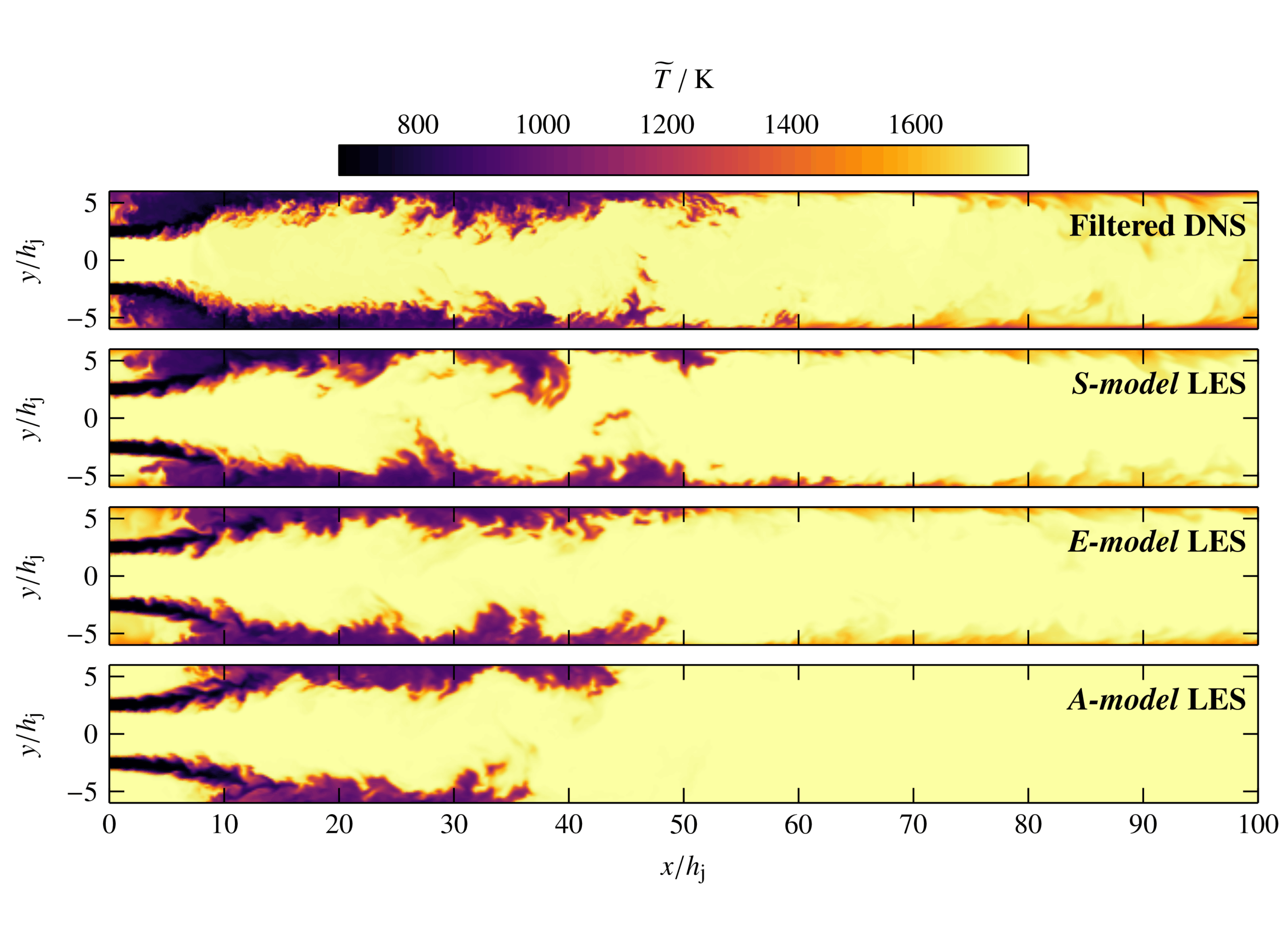Project
A-posteriori Investigation and Validation of Predictive CO Models for LES
The reduction of emissions is an important aspect within the development process of gas turbine combustors. Due to increasingly stringent emissions regulations, optimization of combustion chambers regarding emissions is required. Numerical simulations, in particular large-eddy simulations (LES), play an important role in the development process while reducing development costs. A series of LES were performed of a configuration that represents combustion chambers of stationary gas turbines. The aim of this project was the accurate prediction of carbon monoxide (CO) emissions. Kinetically controlled CO emissions strongly increase in low-load scenarios, limiting the gas turbines load flexibility. A novel CO model has been developed and validated within this project. The CO model is expected to improve the predictiveness of LES, reducing the development effort for future gas turbines. LES are a valuable tool for combustion research and development. They resolve the large scales of turbulence and combustion, only modeling the smallest scales. Thus, they are significantly more accurate and predictive than mean-value techniques such as Reynolds-averages Navier-Stokes (RANS). However, the required computational power is higher, necessitating the use of HPC systems for a reasonable time-to-solution.
Project Details
Project term
July 1, 2024–July 25, 2025
Affiliations
RWTH Aachen University
Institute
Institute for Combustion Technology (ITV)
Principal Investigator
Methods
All simulations are performed with the in-house code CIAO, based on the numerical algorithms developed by Desjardins et al. (Desjardins.2008). It is a semi-implicit finite-differences code with Crank-Nicolson time advancement and an iterative predictor-corrector scheme. Spatial and temporal staggering is employed to increase accuracy and stability. The Navier-Stokes equations are solved in the low-Mach limit. Due to the low-Mach formulation, an elliptic Poisson equation is solved for the pressure, enforcing mass conservation. The momentum equations and the diffusive terms in the scalar transport equations are discretized with fourth-order schemes. The convective terms in the scalar transport equations are discretized by a fifth-order WENO scheme ensuring bounded solutions. The subgrid stress in the momentum equation is modeled by a dynamic Smagorinsky model with Lagrangian averaging. The subgrid scalar flux is closed using the turbulent diffusivity computed from a dynamic Smagorinsky model. A full description of the subgrid modeling implemented in the code is found in Knudsen et al. (Knudsen.2013). The time step is controlled by the Courant-Friedrichs-Lewy (CFL) condition and limited to a CFL number of 0.5. Additionally, the maximum time step is limited to to ensure accurate integration of the chemistry. Statistics are collected over five flow through times after a statistically steady is reached.
Results
The results presented here all apply to the most recent year of the project.
A reduced order combustion model for LES was formulated and evaluated a posteriori. The combustion model is a tabulated chemistry type model, tabulating pre-calculated 1D detailed chemistry flamelets via a combustion progress variable, an enthalpy term to account for wall heat loss, and an OH flamelet index to consider turbulent strain. Additionally, a transport equation for the CO mass fraction was implemented to enable accurate predictions of CO emissions. The LES were performed of a domain with two parallel premixed turbulent jet flames interacting with isothermal walls. This domain has been previously investigated by DNS (Niemietz.2023), allowing for detailed analysis and comparison of the LES results. In addition to the full model, derivative model versions were investigated to analyze the effects of the individual model components. The enthalpy term improved the predictions of global flame properties such as the flame length and fuel flux by capturing the influence of the wall heat loss. However, the inclusion of strain had the largest impact on the global flame properties. By accurately modeling the influence of turbulent strain, average temperatures were reduced and the flame length increased. Finally, the transport equation for CO significantly improved CO predictions compared to the tabulated values, particularly in the near-wall region.
Discussion
Two areas for future refinement of the model were found. Because of the method of enthalpy variation, the lowest enthalpy values from the DNS were not reproduced in the chemistry table. A consistent formulation for this lowest enthalpy range should be investigated, e.g. (vanOijen.2000). The strained model performed very well in the turbulent jets and the turbulence-driven flow regions. Close to the walls, where the flow field is less turbulent and more strongly affected by wall heat loss, the model became less accurate. In future work, increased resolution of low-strain flamelets in the chemistry table and a blending factor between strain dominated regions and enthalpy dominated regions could be implemented. While these refinements should be investigated in future work, the combination of strained flamelets and enthalpy loss with a transport equation for CO significantly improves the predictive capabilities of the models.
Additional Project Information
DFG classification: 404 Fluid Mechanics, Technical Thermodynamics and Thermal Energy Engineering
Software: CIAO
Cluster: CLAIX
Publications
Niemietz, Kai – Numerical Analysis and Modeling of Carbon Monoxide in Turbulent Premixed Jet Flames with Flame-Wall Interaction, PhD thesis
Niemietz, Kai; Gauding, Michael; Pitsch, Heinz – Modeling CO in large eddy simulations of premixed turbulent jet flames with flame-wall interactions, Combustion and Flame (under Review)
Niemietz, Kai ; Scherding, Clément ; Gemassmer, Walter ; Sayadi, Taraneh ; Pitsch, Heinz – An Adaptive-Learning Framework for Chemistry Tabulation in Turbulent Reacting Flows, https://dx.doi.org/10.2139/ssrn.5286473
Niemietz, Kai ; Steinhausen, Matthias ; Hasse, Christian ; Attili, Antonio ; Pitsch, Heinz – A-priori analysis of CO modeling approaches for premixed turbulent jet flames with flame-wall interaction, https://dx.doi.org/10.1016/j.combustflame.2025.114242
 Instantaneous temperature fields from the filtered DNS and the three LES model versions.
Instantaneous temperature fields from the filtered DNS and the three LES model versions.